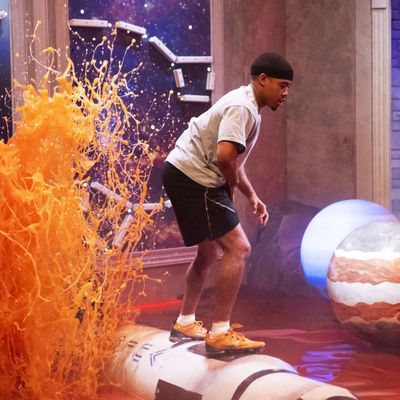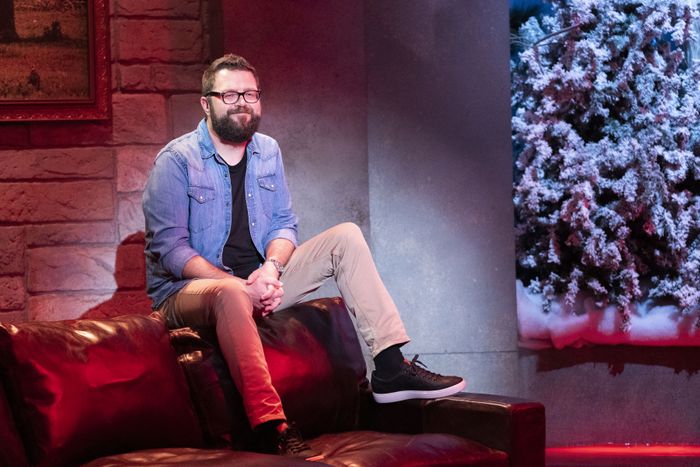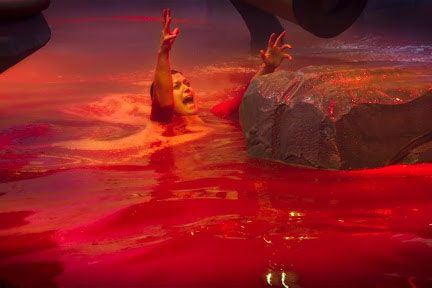
The name of Netflix’s Floor Is Lava is all you really need to know about the show: It’s the don’t-touch-the-floor game you played as a kid, but instead of playing in your living room over shag carpeting, you’re on a fully realized obstacle course making six-foot leaps over roiling orange liquid. It’s another on a long list of obstacle-course-based competition reality shows, which includes recent entries like American Ninja Warrior and Holey Moley and goes back to ’90s childhood favorites like Nickelodeon’s GUTS and Legends of the Hidden Temple. Like the best of these shows, Floor Is Lava passes the crucial “I would totally do this, and I would probably be great at it” test.
But Floor Is Lava’s ten episodes are also weirdly slapdash and underbaked. The number of teams and competitors fluctuates from episode to episode, flashy interstitial graphics come and go, and the show can’t decide whether it wants host Rutledge Wood to be a physical presence or an enthusiastic, disembodied voice in the sky. Still, Floor Is Lava is the only game show we’ve ever seen where grown adults scream in pantomimed despair after their teammates fall into fake lava; it would be a shame if it failed to live up to its full potential. And so, as students of the genre, we have a few very serious suggestions for how to improve this very silly show.
Let the teams see each other
In each episode of Floor Is Lava, two or three teams of two or three people have to get from the start of one lava-filled obstacle course to the end. But despite being in direct competition, the teams on Floor Is Lava never acknowledge each other. Each run begins with an awkward green-screen “interview” where a trio of teammates riff on the modest biographical info provided, never once mentioning their opponents by name. It’s unclear if they even know who the other teams are. What little competitive spirit the show can muster is created in the editing room with split-screen footage comparing one team’s wipeout to another’s.
If there are OSHA regulations about how many people can be in a lava room at once, at least let us watch teams watch each other’s runs. American Ninja Warrior mines this human drama frequently in later rounds of competition, cutting between shots of superhuman agility and shots of fallen competitors trying to decide whether to root for their opponent or for the course itself.
The producers’ decision to hermetically seal each victorious team’s celebration also deprives us of a classic game-show moment: seeing the loser interact with the winner. Watching losers stare vacantly as the host congratulates the winners is a flavor of Schadenfreude as potent as watching arrogant triplets fall one by one into lava. Floor Is Lava would do well to cultivate it.
Set a time limit
For every teammate who makes it across the lava room, the team gets a point. In the case of a tie (which happens constantly, because there is no other way to score points, more on that in a minute), the team that made it through the course fastest wins. A timer occasionally pops up to remind the audience how much time has passed. The problem is that the teams themselves don’t actually seem aware of the timer.
Our solution? Set a time limit for completing each course, and hang a big ol’ countdown clock above the exit. This creates additional pressure on teams to pick up the pace, and encourages risks that would make for more impressive stunts and more devastating falls — a person with two minutes left on a clock is going to make different decisions than a person with ten minutes left.
Free Rutledge Wood
These obstacle course shows don’t need a strong host, because the most important character is the course. But a good one can add personality and have friendly chats with competitors before and after they attempt the courses, freeing us from the generally awful canned interview segments that bookend each run. For the 17 seconds of each episode that he appears onscreen, Rutledge Wood seems like a charismatic and friendly presence. Let him actually talk with some people next time (social-distancing guidelines permitting).
Give teams more ways to score points
Too many episodes of this show end on an underwhelming, anticlimactic note due to unceremonious timer-based tiebreaker endings. And teams that do worse than the first team to run the course automatically fail: If the first team in the episode gets two people across, and two people on the second team fall into the lava, we fade to black and move on without getting closure.
Instead, give players one or two other ways to score points, maybe by going out on a limb to collect weird objects, or getting a bonus point for being especially fast. More opportunities for points means more variation in scores, which means fewer ties; it also gives individuals who outlast their teammates a fighting chance to stay in the game.
Let us know what the players know
Floor Is Lava skips the part of classic obstacle-course shows where a host tells the players the rules. Players emerge into an open doorway, armed with some knowledge of how things are going to go. But it’s never clear what exactly they’ve been told. Rules like “if an item touches lava, you can’t use it” are never said out loud, yet every team knows it; same for “getting splashed by a plume of lava doesn’t kill you, you have to actually fall in.” And some teams seem to know puzzle solutions before they’ve even taken their first jump. This undercuts the drama inherent to any athletic competition and often makes for disorienting viewing.
Why not create some dramatic irony by letting us see the course in full and then give the players an incomplete map, or clues as to what the room holds? We’ll enjoy knowing more than they do, and a tense planning session could be a fun replacement for the awkward team intros.
Tell us the story of Lava House
After each title sequence assures us that the floor will once again be lava, Rutledge narrates a computer-generated tour of the room our contestants will attempt to conquer. But he never tells us whose room it is, or why they flooded it with lava, or why the kitchen has a giant pizza oven that magically spits out fresh pies and the third one always comes with pepperoni, mushrooms, and a giant silver key. These teams were ostensibly trapped in this house by someone, and the lack of a coherent fictional backdrop leaves Rutledge rudderless in his commentary about their adventures through each course. He has no answer as to why there’s a green space alien in the ancient sarcophagus, for example. It’s just there. And he has to come up with something to say about it three different times.
Imbuing the signature obstacles with a little bit of lore would help to ground the commentary and also make the room elements more memorable for the audience, heightening the drama each time a contestant attempts to swing on Colonel Vesuvius’s Mozzarella Stick.
More Lava
No, really. Just add more of it. Shots like this should happen every episode:






